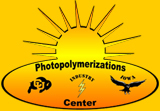
![]()
Industries in Research Center Group
Current Member Companies:
3M Sartomer DSM Johnson & Johnson Vision Care
Employees of these companies are invited to visit the Members Only section.
Click Here to View a Letter from the Advisory Committee
Why join the Photopolymerization Center?Photopolymerization is one of the most rapidly expanding processes for materials production with more than 20% annual growth. Photopolymerizations have gained prominence in recent years for the pollution-free curing of polymer films as well as emerging applications in dental materials, electronic and optical materials, conformal coatings, and high resolution rapid prototyping of 3D objects. These solvent-free polymerizations proceed very rapidly with a fraction of the energy requirements of thermally cured systems, and the resulting polymeric materials possess extremely useful properties. For example, these reactions can be used to form highly crosslinked, thermally stable polymer films exhibiting excellent adhesion, abrasion resistance and chemical resistance while not emitting or requiring volatile organic components. In addition to the broad utility of the polymers that are formed, the photopolymerization process itself affords many advantages, including very high reaction rates at room temperature, spatial control of the polymerization, low energy input and chemical versatility, since polymerization of a wide variety of monomers can be initiated photochemically.
Due to the advantages outlined above, photopolymerizations are playing an increasingly important role in a variety of industries; therefore, the IUCRC will seek broad-based support from a variety of companies representing both established and emerging applications of photopolymerizations. For example, photopolymerizations are firmly established as the method of choice for continuous, high-speed coating operations. These applications range from web processes in which an organic coating is placed onto a paper or plastic substrate, to optical fiber coating systems in which an extremely high-speed reaction is required to place a protective coating onto a glass fiber being pulled at rates exceeding 100 feet per second. For these applications, it is imperative that the polymerization kinetics are well understood since the coating must be cured to a tack-free level before the process is complete. Therefore, the information provided by the fundamental kinetic and mechanistic studies to be carried out in the center will provide information that will allow the companies to optimize current processes, and identify promising reaction systems for new processes.A second category of companies with which the IUCRC will interact on established applications of photopolymerizations are resin and initiator suppliers. These companies provide the reactive materials that the end-users employ in applications. These suppliers are constantly developing innovative new reactive systems that offer advantages over the traditional formulations; therefore, the IUCRC would provide an invaluable service to these companies by independently characterizing the kinetics of these polymerizations as well as the thermal and mechanical properties of the resulting polymers. In addition, since the IUCRC industrial review board will include many end-users who would purchase raw materials from these companies, the center would enhance the rate at which innovative new systems are adopted within the industry.
In addition to the established applications of photopolymerizations, center research will be directed toward emerging applications of these reactions. The goal of this high-risk, cutting-edge research is to expand the applicability of photopolymerizations, demonstrating the utility of these reactions in unexplored systems and processes. Examples of the type of research include photopolymerizations of thick, fiber-filled polymers and advanced, biomedical applications of photopolymerizations. For example, in recent research the PIs have demonstrated two strategies for effective photopolymerizations of thick (up to a few centimeters) polymers and composites. The first strategy combines careful selection of the initiating wavelength with the reactive system including the resin/monomer, initiator formulation and their relative concentrations to produce “self-eliminating” light intensity gradients. Here, we ensure that the photochemical event which leads to the initial light intensity gradient actually leads to its elimination. In the second strategy, a hybrid photo/thermal initiating mechanism is employed where the heat evolved from the highly exothermic photochemical reaction elevates the temperature of the system such that a second, thermal reaction occurs resulting in the production of additional active sites. Similarly, the PIs of this proposal are developing new reaction systems and strategies for sub-dermal photopolymerizations, intraoperative curing of degradable polymers for frature fixation in orthopedics, and custom production of devices using high speed, high resolution 3-D prototyping techniques.
The final class of industry that will be targeted by this IUCRC will be companies involved with the microelectronic and liquid crystal display industries. In these fields, the ability to control a polymerization (by spatially directing the initiating light) plays a central role in the fabrication process. An understanding of the underlying photochemical processes is imperative in these emerging, high-tech applications (especially with the advent of advanced, chemically amplified resists used in deep-UV lithography). Therefore, the fundamental information obtained in the IUCRC research will again play an enabling role for the optimization of industrial processes.


